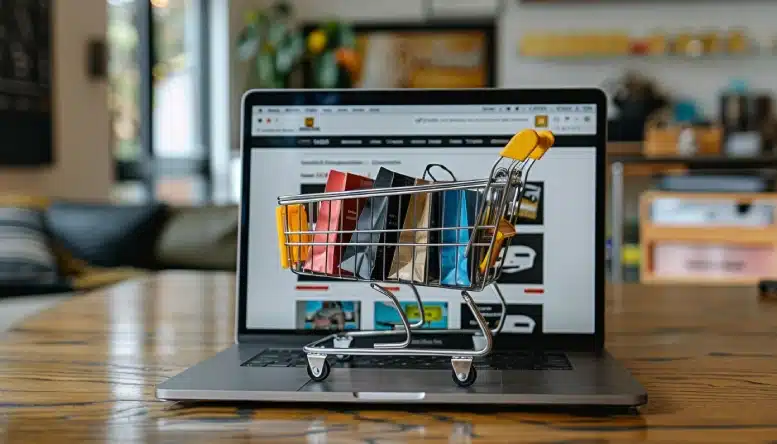The retail landscape has undergone a dramatic transformation over the last two decades, driven primarily by the rise of e-commerce. Once dominated by brick-and-mortar stores, the global retail market has evolved into a digital-first ecosystem where consumers shop anytime, anywhere. The growing influence of online shopping has profoundly affected traditional retail stores, reshaping consumer expectations, business strategies, and the overall retail economy. Understanding these changes is critical for businesses aiming to adapt, survive, and thrive in this new era.
The Digital Shift in Consumer Behavior
The way people shop has changed forever. Consumers today value convenience, speed, and personalization, qualities that online shopping inherently provides. Digital platforms have empowered customers with access to unlimited product options, instant price comparisons, and doorstep delivery—all without leaving their homes.
The Power of Convenience
Online shopping platforms have simplified the buying process, reducing the friction traditionally associated with in-store experiences. Instead of driving to multiple stores, standing in lines, or navigating crowded malls, consumers can now browse thousands of products in seconds. The ability to shop 24/7 has also made online platforms more appealing to busy professionals and families.
The Rise of Informed Consumers
With access to customer reviews, social proof, and price-tracking tools, shoppers are more informed and selective than ever. They compare not only prices but also quality, brand reputation, and service experiences. This transparency has increased competition, putting pressure on traditional retailers to improve their offerings and pricing strategies.
The Impact of Mobile Shopping
Mobile commerce has intensified the shift from physical to digital retail. Smartphones have turned into personal shopping assistants, allowing users to browse, purchase, and track orders with a few taps. Retailers that fail to optimize their digital presence for mobile users risk losing a significant portion of their customer base.
The Decline of Foot Traffic in Traditional Retail
The most visible effect of online shopping on traditional retail is the steady decline in foot traffic. While physical stores once enjoyed consistent customer visits, the ease of online purchasing has diverted much of this traffic to digital channels.
Reduced In-Store Visits
Many consumers now visit physical stores only for specific purchases or experiences they cannot replicate online. For instance, luxury goods, personalized services, or products that require tactile evaluation still attract in-person shoppers. However, for everyday goods, electronics, and apparel, the convenience of online shopping has become too appealing to ignore.
The Showrooming Phenomenon
Showrooming has become a common practice where customers visit stores to examine products in person before purchasing them online at lower prices. This behavior undermines traditional retailers’ sales while benefiting online competitors who can offer discounts due to lower operating costs.
Shift in Shopping Frequency
Consumers now shop more frequently but spend less per visit. Online platforms encourage impulse buying through targeted ads and personalized recommendations, while physical stores see fewer large-scale shopping trips. This shift challenges traditional stores to reimagine how they engage customers and drive recurring visits.
Financial Impact on Traditional Retailers
The economic impact of e-commerce on brick-and-mortar stores extends far beyond reduced foot traffic. Traditional retailers face increased operational challenges, higher competition, and evolving consumer expectations.
Rising Costs vs. Shrinking Margins
Physical stores must maintain inventory, pay rent, hire staff, and manage utilities—expenses that online retailers can often minimize. This disparity allows e-commerce platforms to offer competitive pricing while maintaining healthy profit margins. In contrast, traditional retailers struggle to balance overhead costs with shrinking in-store sales.
Store Closures and Downsizing
Many established retail chains have closed underperforming locations in response to declining traffic. Some are converting large stores into smaller, experience-driven spaces or combining digital and physical operations through hybrid models like click-and-collect. This restructuring is a direct response to shifting market dynamics caused by online shopping growth.
Supply Chain and Inventory Adjustments
Traditional retailers are also rethinking supply chain strategies. Instead of stocking large quantities in-store, many now use centralized distribution centers or partner with e-commerce logistics networks to fulfill both online and offline orders more efficiently.
Adapting to a New Retail Ecosystem
While online shopping has created challenges, it has also presented opportunities for traditional retailers willing to innovate. Many are blending physical and digital experiences to meet modern consumer demands.
The Rise of Omnichannel Retailing
Omnichannel retailing integrates online and offline touchpoints to create a seamless customer journey. Examples include ordering online and picking up in-store, returning online purchases at retail locations, or offering digital loyalty programs. This approach allows retailers to combine the convenience of e-commerce with the personal touch of physical shopping.
In-Store Technology Integration
Brick-and-mortar stores are embracing digital transformation by integrating technology into the shopping experience. Interactive displays, smart mirrors, and digital kiosks help customers access additional product information, check stock availability, and even make purchases without waiting in line.
Enhanced Customer Experience
To compete with online shopping, traditional retailers are focusing on customer experience. They are offering personalized services, in-store events, and experiential shopping environments designed to engage customers on an emotional level. For example, hands-on product demonstrations or exclusive in-store promotions create memorable experiences that drive loyalty.
The Role of Data and Personalization
Data analytics has become a critical tool for traditional retailers adapting to the digital age. Online shopping platforms have long used data to personalize recommendations and optimize marketing, and now physical retailers are following suit.
Customer Data Insights
Retailers collect data from loyalty programs, online activity, and point-of-sale systems to understand purchasing behavior. This data helps tailor marketing campaigns, predict demand, and design promotions that align with customer preferences.
Bridging Online and Offline Experiences
By linking digital profiles with in-store activity, retailers can create unified experiences. For example, customers who browse online can receive personalized offers when they enter a store. This integration fosters engagement across multiple channels and increases conversion rates.
Predictive Analytics for Inventory Management
Predictive analytics helps retailers forecast trends and manage inventory more effectively. By analyzing online search patterns and sales data, they can anticipate demand and adjust stock levels to prevent overstocking or shortages.
Employment and Workforce Transformation
The shift toward online shopping has also transformed the retail workforce. While some traditional retail jobs have declined, new roles have emerged in technology, logistics, and digital marketing.
Decline in Traditional Retail Jobs
As physical stores close or reduce size, positions such as cashiers and floor staff are becoming less common. However, this decline is offset by growth in warehousing, delivery, and customer service roles that support e-commerce operations.
New Skill Requirements
Modern retail employees must now be digitally literate. They need to understand online order systems, mobile payment platforms, and customer data management tools. Training programs and workforce reskilling have become essential for retailers aiming to remain competitive.
Remote and Flexible Work Opportunities
Online shopping has also expanded remote work options, especially in customer support, content creation, and digital marketing. This flexibility benefits both employers and employees by reducing costs and broadening talent pools.
The Competitive Advantage of Experience-Based Retail
As online shopping becomes the default choice for convenience, traditional retailers must focus on what e-commerce cannot replicate: tangible, sensory, and emotional experiences.
Experiential Retail Spaces
Retailers are turning their stores into interactive destinations. This includes hosting product workshops, live demonstrations, or exclusive in-store launches. These experiences create a stronger emotional connection with customers and encourage repeat visits.
Community-Centered Retail
Many physical stores are building local communities through events and collaborations with nearby businesses. This strategy transforms shopping into a social experience, strengthening brand identity and fostering loyalty.
Personalized Customer Service
Unlike online platforms, in-store interactions offer real human connection. Trained staff who provide expert advice, personalized styling, or tailored recommendations create value that technology alone cannot replace.
The Future Relationship Between Online and Offline Retail
Despite predictions that online shopping would replace traditional retail entirely, the future points toward coexistence rather than replacement. Physical stores are evolving into strategic assets that complement digital platforms.
Hybrid Business Models
The most successful retailers of the future will seamlessly merge digital and physical operations. Hybrid models such as “click and collect,” “ship from store,” and “endless aisle” are becoming standard, giving consumers flexibility in how they shop.
The Role of Artificial Intelligence
AI will play a crucial role in shaping future retail experiences. From personalized product recommendations to automated customer support, AI enhances both online and offline engagement. In physical stores, AI-powered tools can predict shopping trends and optimize inventory placement.
Sustainability and Ethical Shopping
Both online and offline retailers face increasing pressure to adopt sustainable practices. Consumers prefer brands that reduce waste, use eco-friendly packaging, and prioritize ethical sourcing. Traditional retailers can leverage sustainability as a competitive differentiator by promoting transparency and responsible business practices.
FAQs
Q1: Is online shopping completely replacing traditional retail stores?
No, online shopping is reshaping—not replacing—traditional retail. Physical stores still play a vital role in providing experiences, personal service, and immediate product access that online platforms cannot fully replicate.
Q2: How can traditional retailers compete with e-commerce platforms?
They can focus on enhancing customer experiences, adopting omnichannel strategies, leveraging data analytics, and offering personalized services that build long-term relationships.
Q3: What types of products do consumers still prefer to buy in stores?
Shoppers often prefer to buy items like clothing, furniture, and luxury goods in stores, where they can assess quality, fit, and aesthetics firsthand.
Q4: How does online shopping affect local businesses?
Online shopping can challenge local stores by reducing foot traffic, but it also provides opportunities for small businesses to expand their reach through digital platforms.
Q5: What will the future of retail look like?
The future will blend online convenience with offline engagement. Physical stores will evolve into experience-driven spaces, while e-commerce continues to grow through personalization, AI, and sustainable practices.
The rapid rise of online shopping has reshaped the global retail landscape, creating both challenges and opportunities for traditional stores. While digital platforms dominate convenience, brick-and-mortar retailers retain an irreplaceable advantage in experience and personal connection. The path forward lies in integration—where digital innovation enhances physical retail, creating a hybrid ecosystem that defines the future of shopping.













